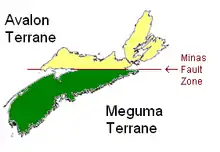Meguma terrane
The Meguma terrane, also known as Megumia, is a terrane exposed in southern Nova Scotia, that became joined to the present North American landmass as part of the Appalachian orogeny.

The exposed part of the Meguma terrane, the Meguma Group, is largely composed of c. 10 km (6.2 mi) thick Cambrian to Ordovician turbidites that have been interpreted as submarine fan deposits.[1] The Meguma terrane is joined to the Avalon terrane along the Minas Fault Zone, which runs east–west from Chedabucto Bay to Cobequid Bay and the Minas Basin.[2] The Meguma Group is intruded by numerous Devonian and Carboniferous plutons.[3]
The extent of the formation is unclear; some geologists believe that a magnetic anomaly along the coast of Cape Cod may represent a suture between the Meguma and Avalon terranes in that region.[4] Unlike the Avalon terrane, the Meguma terrane has not been definitely associated with a territory on the other side of the Atlantic. It may be represented in either the Galicia-Tras-Os-Montes Zone in Spain and Portugal; the West African Craton in Morocco; or the Amazonian Craton.[5] Meguma was, nevertheless, part of Gondwana during the Cambrian, and possibly formed a single peri-Gondwanan fragment together with Avalon. Meguma then became shortened during the Acadian orogeny but Avalon somehow escaped those Acadian deformations.[6]
Geologically this area is of interest not only to students of geological history, but because metamorphism produced gold deposits which were mined extensively (up to 30,000 ozt/a (930 kg/a)) in the latter half of the 19th century, and which remain potentially exploitable today during periods of higher gold prices.[7]
See also
- Ganderia, also known as Gander terrane – Terrane in the northern Appalachians which broke off the supercontinent Gondwana
- Rheic Ocean – Ancient ocean which separated two major palaeocontinents, Gondwana and Laurussia
References
- Notes
- Waldron et al. 2005, Maguma Terrane in Nova Scotia, p. 4
- Sangster & Smith 2007, Regional Geology and Tectonic Setting, pp. 724–725
- Horne et al. 2007
- Hallett et al. 2003, Geologic setting
- Nance et al. 2010, p. 211
- Waldron et al. 2005, History of the Avalon-Meguma Boundary, p. 5
- Sangster & Smith 2007, Introduction and history, pp. 723–724
- Sources
- Hallett, B. W.; Paskevich, V. F.; Poppe, L. J.; Brand, S. G.; Blackwood, D. S. (2003). "A Pictorial Survey of the Bedrock beneath Western Cape Cod, Massachusetts". Open-File Report OF-2003-221. United States Geological Survey. Retrieved 3 February 2018.
- Horne, R. J.; Culshaw, N.; White, C. E.; Kontak, D. (2007). Neoacadian deformation within the Meguma terrane. Northeastern Section - 42nd Annual Meeting. Vol. 39. Geological Society of America. p. 69. Retrieved 3 February 2018.
- Nance, R. D.; Gutiérrez-Alonso, G.; Keppie, J. D.; Linnemann, U.; Murphy, J. B.; Quesada, C.; Strachan, R. A.; Woodcock, N. H. (2010). "Evolution of the Rheic ocean". Gondwana Research. 17 (2–3): 194–222. Bibcode:2010GondR..17..194N. doi:10.1016/j.gr.2009.08.001. Retrieved 3 February 2018.
- Sangster, A. L.; Smith, P. K. (2007). "Metallogenic summary of the Meguma gold deposits, Nova Scotia" (PDF). In Goodfellow, W. D. (ed.). Mineral deposits of Canada: a synthesis of major deposit-types, district metallogeny, the evolution of geological provinces, and exploration methods. Special Publication. Vol. 5. Geological Association of Canada, Mineral Deposits Division. pp. 723–732. Retrieved 3 February 2018.
- Waldron, J. W.; White, J. C.; MacInnes, E.; Roselli, C. G. (2005). Field Trip B7: Transpression and transtension along a continental transform fault: Minas Fault Zone, Nova Scotia (PDF). AGS Special Publication. Vol. 33. Atlantic Geoscience Society. hdl:10222/53771. ISBN 9780973798227.